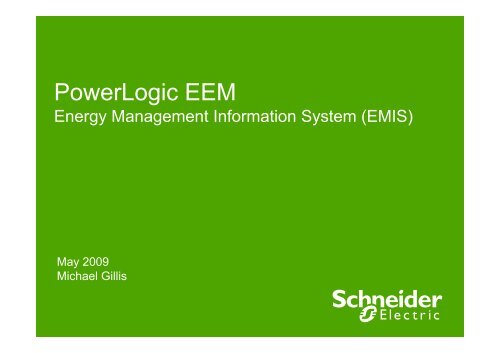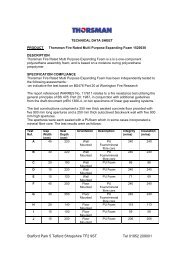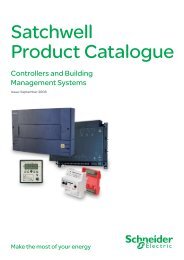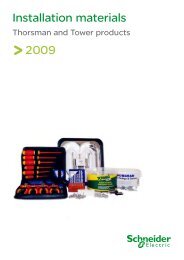PowerLogic EEM - Energy Management Information System (EMIS)
PowerLogic EEM - Energy Management Information System (EMIS)
PowerLogic EEM - Energy Management Information System (EMIS)
You also want an ePaper? Increase the reach of your titles
YUMPU automatically turns print PDFs into web optimized ePapers that Google loves.
<strong>PowerLogic</strong> <strong>EEM</strong><br />
<strong>Energy</strong> <strong>Management</strong> <strong>Information</strong> <strong>System</strong> (<strong>EMIS</strong>)<br />
May 2009<br />
Michael Gillis
The global energy dilemma<br />
Schneider Electric 2
The energy and CO 2 emission challenge<br />
World consumption up<br />
45% since 1980, 70%<br />
higher by 2030<br />
Emerging markets<br />
> 75% of new demand<br />
CO2 up 33% since<br />
industrial revolution,<br />
rising faster than ever<br />
Resource competition &<br />
political instability keep<br />
prices high<br />
●Coal use continues to grow in emerging markets<br />
These trends are here to last unless we act!<br />
Schneider Electric 3
Leaving the car in the garage will not be enough…<br />
GHG emission<br />
Transportation<br />
Industry and buildings<br />
energy usage<br />
(includ. Data centres)<br />
Data extracted from WRI: navigating the numbers 2005<br />
14%<br />
44%<br />
Improved efficiency<br />
significantly impacts<br />
GHG reduction!<br />
Schneider Electric 4
Industry is the “leader” in GHG<br />
31%<br />
Industry<br />
& Infrastructure<br />
>2%<br />
Data centres &<br />
networks<br />
18%<br />
Buildings<br />
Source:<br />
EERE Building <strong>Energy</strong> Data book 2006<br />
EERE Manufacturing <strong>System</strong>s Footprint ,<br />
http://www1.eere.energy.gov/industry/energy_systems/pdfs/mfg_footprint.pdf<br />
21%<br />
Residential<br />
28%<br />
Transportation<br />
Schneider Electric 5
<strong>Energy</strong> challenges & opportunities are everywhere<br />
Supply Side<br />
More Efficient and<br />
Cleaner Supply<br />
Demand Side<br />
More Efficient Use Conservation<br />
& <strong>Management</strong><br />
Schneider Electric 6
<strong>Energy</strong> challenges & opportunities are everywhere<br />
Supply Side<br />
More Efficient and<br />
Cleaner Supply<br />
Cleaner supplies will take<br />
time to implement<br />
Demand Side<br />
More Efficient Use Conservation<br />
& <strong>Management</strong><br />
Current technologies allow us<br />
to target 30% savings<br />
Schneider Electric 7
<strong>Energy</strong> challenges & opportunities are everywhere<br />
Supply Side<br />
More Efficient and<br />
Cleaner Supply<br />
Cleaner supplies will take<br />
time to implement<br />
We must develop technologies<br />
and business models to increase<br />
renewable energies penetration<br />
Mid term approach<br />
Demand Side<br />
More Efficient Use Conservation<br />
& <strong>Management</strong><br />
Current technologies allow us<br />
to target 30% savings<br />
We must focus on <strong>Energy</strong><br />
Efficiency to solve our energy<br />
dilemma<br />
Short term action<br />
Schneider Electric 8
<strong>Energy</strong> efficiency is a responsibility and the challenge<br />
<strong>Energy</strong> Conservation<br />
Environmental <strong>Management</strong><br />
Schneider Electric 9
Green House Gas (GHG) emissions - a new commodity.<br />
● How do you account for the changing relationships between<br />
emission factors,<br />
input parameters,<br />
and the sources consuming the energy.<br />
● What is your aggregate CO2e Output<br />
vs. Target<br />
vs. Baseline Year?<br />
Schneider Electric 10
Kyoto Protocol<br />
● Part of the United Nations Framework Convention on Climate Change (UNFCCC)<br />
● Adopted for use in December 1997 in Kyoto, Japan<br />
● The objective is to stabilize greenhouse gas concentrations using 1990 as the base<br />
year for reduction objectives<br />
● As of 2008 183 countries have ratified the protocol:<br />
Schneider Electric 11
Greenhouse Gases (GHGs)<br />
● Greenhouse gases covered by the Kyoto Protocol:<br />
● Derived:<br />
●Carbon Dioxide (CO 2 )<br />
●Methane (CH 4 )<br />
●Nitrous Oxide (N 2 O)<br />
● Directly Measured:<br />
●Hydrofluorocarbons (HFCs)<br />
●Perfluorocarbons (PFCs)<br />
●Sulphur Hexafluoride (SF 6 )<br />
Schneider Electric 12
<strong>Energy</strong> Efficiency: “it's easy”, just follow the 4<br />
sustainability steps<br />
1.Measure<br />
2.Use efficient devices<br />
3.Automate<br />
4.Monitor and Improve<br />
Schneider Electric 13
The 4 sustainability steps<br />
1.Measure<br />
2 Use efficient devices<br />
3 Automate<br />
4 Monitor and Improve<br />
●Audits and Planning<br />
●<strong>Energy</strong> meters<br />
●Power quality meters<br />
Schneider Electric 14
The 4 sustainability steps<br />
1 Measure<br />
2.Use efficient devices<br />
3 Automate<br />
4 Monitor and Improve<br />
●Low consumption devices<br />
●Insulation material<br />
●Power quality<br />
●Power reliability<br />
Schneider Electric 15
The 4 sustainability steps<br />
1 Measure<br />
2 Use efficient devices<br />
3.Automate<br />
4 Monitor and Improve<br />
●Variable speed drive<br />
●Motor control systems<br />
Schneider Electric 16
The 4 sustainability steps<br />
1 Measure<br />
2 Use efficient devices<br />
3 Automate<br />
4.Monitor and Improve<br />
● <strong>Energy</strong> management software<br />
● Remote monitoring systems<br />
Schneider Electric 17
<strong>Energy</strong> <strong>Management</strong> <strong>Information</strong> <strong>System</strong> (<strong>EMIS</strong>)<br />
● Promote behavior change<br />
● Awareness<br />
● Accountability<br />
● Identify savings opportunities<br />
● Operation & Maintenance (O & M) program support<br />
● <strong>Energy</strong> Conservation Measure (ECM) identification and prioritization<br />
● Audit savings to ensure long term persistency<br />
● Operation & Maintenance (O & M) program support<br />
● <strong>Energy</strong> Conservation Measure (ECM) identification and prioritization<br />
Schneider Electric 18
<strong>PowerLogic</strong> <strong>EEM</strong>: Enterprise-class energy management tools<br />
● Complete,<br />
reliable data<br />
● Powerful<br />
visualization<br />
● <strong>Energy</strong><br />
modeling<br />
● Billing and rate<br />
engine<br />
Schneider Electric 19
Reports<br />
● Key values of interest<br />
● <strong>Energy</strong> / per product / per unit<br />
● <strong>Energy</strong> usage<br />
● <strong>Energy</strong> demand<br />
● Spend ($/€)<br />
● Greenhouse gas<br />
● Different levels of detail<br />
● Corporate/global<br />
● Operating division<br />
● Other levels of organization (Plant<br />
type, process, etc)<br />
● Individual site, work shift, etc<br />
● Sub-metered zones or loads<br />
Worldwide Regional Sites Zone/Process<br />
● Different needs<br />
● Summary data for management or<br />
external use<br />
● Exception reporting to detect problem<br />
areas<br />
● Detailed information for decision making<br />
● <strong>EEM</strong> tools will allow users to create our own<br />
reports<br />
Schneider Electric 20
Actively Manage Peak Demand and <strong>Energy</strong> Use<br />
● Optimize demand and<br />
power factor<br />
management<br />
● Optimize start-up<br />
procedures and load<br />
sequencing<br />
● Measure and verify the<br />
results of upgrades or<br />
process changes<br />
● Integrate with power<br />
management systems<br />
● Coordinate with demand<br />
response, load<br />
curtailment or real-time<br />
pricing programs<br />
Schneider Electric 21
Benchmark and Compare Performance<br />
● Compare plants, cost<br />
centers, processes<br />
● Metrics: MWh, cost,<br />
CO2e/NOx, and more<br />
● Normalize for<br />
temperature, sq. ft,<br />
production units<br />
● Compare against<br />
industry benchmarks<br />
● Identify and isolate<br />
efficient<br />
systems/behaviors<br />
● Document for “green”<br />
ratings<br />
Schneider Electric 22
Model, Track, and Verify Return on Investment<br />
● Model and predict<br />
savings<br />
● Assess project risk<br />
● Set a baseline and<br />
track performance KPIs<br />
against goals<br />
● Summarize budget<br />
projections for<br />
executives<br />
● Analyze variances,<br />
make adjustments, stay<br />
on track<br />
● Attribute savings,<br />
validate investments<br />
Schneider Electric 23
Allocate Costs and Effect Change of Behavior<br />
● Expose energy-related<br />
costs to individual users to<br />
drive accountability<br />
● Allocate costs by<br />
department or cost center<br />
based on actual usage<br />
● Determine unit or marginal<br />
cost of production<br />
● Prepare energy budgets<br />
for departments or<br />
processes<br />
Schneider Electric 24
Optimize Budgeting and Procurement<br />
● Consolidate<br />
consumption for each<br />
facility<br />
● Use complex utility<br />
rate modeling and<br />
“what-if” scenarios to<br />
compare rates or<br />
suppliers<br />
● Aggregate loads<br />
● Forecast future needs<br />
and accrue costs<br />
● Verify utility billing and<br />
contract compliance<br />
Schneider Electric 25
Reduce Capital and Operations Costs with Forecasts<br />
● Maximize use of existing<br />
infra-structure to minimize<br />
capital expenditures<br />
● “Right size” capacity of new<br />
facilities<br />
● Correlate operational<br />
parameters and efficiency<br />
to determine stresses<br />
● Optimize settings on<br />
chillers and compressors<br />
for best efficiency<br />
● Balance generator<br />
efficiency against usage<br />
Schneider Electric 26
Identify Root Causes and Opportunities for Savings<br />
● Isolate the drivers of<br />
inefficiencies<br />
● Break down<br />
consumption by utility,<br />
time period, load<br />
(chillers, boilers,<br />
motors, heaters)<br />
● Trend and analyze<br />
hidden patterns and<br />
non-linear relationships<br />
(energy vs. emissions)<br />
● Prioritize projects with<br />
greatest ROI potential<br />
Schneider Electric 27
Environmental Sustainability Module<br />
● Calculates CO2 out for all fuel types<br />
by facility and for the aggregate<br />
● Compare performance vs. baseline<br />
year and monthly targets<br />
● Flexible architecture<br />
● Apply CO2 emissions factors<br />
from utility<br />
● Supports “slowly changing”<br />
variables<br />
● Dedicated Admin user interface for<br />
managing emissions factors and<br />
targets<br />
● Adheres to the international GHG<br />
Protocol framework<br />
● MAP BASED NAVIGATION<br />
(Next Slide)<br />
Schneider Electric 28
Emission Reporting<br />
Total Emissions Report<br />
� Total Yearly Emissions vs. Base Year<br />
� Total Monthly Emissions vs. Base Year and Target<br />
� Total Emissions per Commodity<br />
Emissions Comparison and Variance Report<br />
� Emissions per source<br />
� Variance from Target per source<br />
� Variance from Base Year per source<br />
Schneider Electric 29
Country level report point<br />
Schneider Electric 30
Configurable links to report content<br />
Click a point to bring up the available reports<br />
Schneider Electric 31
Power Quality Module<br />
� Steady state analysis of RMS voltages, current, power, frequency, imbalance,<br />
harmonic distortion, sag/swells, transients, phasors, and symmetrical components<br />
� Compliance summaries (ie. SARFI, EN50160, IEEE1159) with trending<br />
� Plots events against industry-standard or custom tolerance curves (ITI, CBEMA, SEMI-<br />
F47), with mapping of events indicating type, classification, age, severity, etc<br />
� Use tools to help reduce data and correlate multiple events with a root cause<br />
� Summarize events within a time range or other dimension to produce a single representative<br />
event, … then drill down on a selected summary event to reveal the list of supporting events.<br />
� Visually delineate events using symbols and colors for phase, type, age or other dimension<br />
� Classify events by attributes, add a custom annotations and then filter on that classification<br />
� Waveform analysis with zooming, event details, stacking, and RMS overlays<br />
Schneider Electric 32
Real-time Data - Process<br />
<strong>EEM</strong> can be linked to other systems that utilize a WEB enabled user<br />
interface, for real-time data views with navigation via the browser.<br />
Schneider Electric 33
Real-time Data - Electrical<br />
ION Enterprise Real-time electrical one-line screen (Cement – Columbia)<br />
Schneider Electric 34
Data convergence delivers energy insights<br />
<strong>Energy</strong> Performance Green House Gas Power Demand Cost Allocation MES Analysis<br />
Schneider Electric 35
<strong>Energy</strong> Efficiency initiatives need to<br />
answer<br />
key Questions<br />
Schneider Electric 36
These Questions are..<br />
1 Where to start & what does it give me in return?<br />
● Consult/Do an audit<br />
● Opportunities are all around us. Measure & Analyze<br />
● For many EE projects, pay back time is < 2 years<br />
2 Where to focus?<br />
● Identify potential actions for<br />
Reduction of consumption<br />
Optimization of cost<br />
Improvement of Reliability & Availability<br />
3 What are the enabling solutions?<br />
4 How do I maintain the improvements?<br />
● Consulting / remote monitoring<br />
Schneider Electric 37
Make the most of your energy








